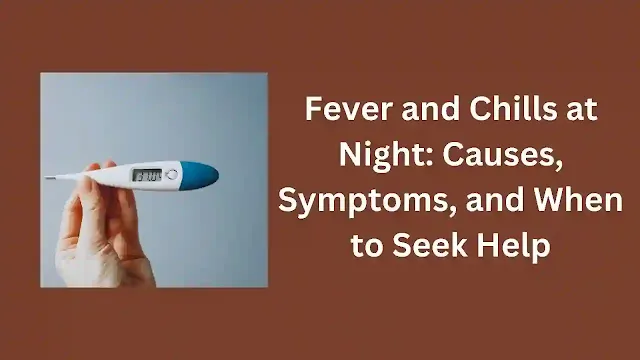Fever and Chills at Night: Causes, Symptoms, and When to Seek Help
Fever and Chills at Night: Causes, Symptoms, and When to Seek Help - Fever and chills at night can be unsettling and often raise concerns about what's going on in your body. A fever is typically a temporary rise in body temperature, while chills are sensations of coldness, usually accompanied by shivering.
Understanding why these symptoms occur can
provide valuable insight into your health. This guide explores the relationship
between fever and chills, the common causes, and when it's important to seek
medical attention.
What Are Fever and Chills?
Fever
Fever is defined as a body temperature above the
normal range of around 98.6°F (37°C). It's usually a sign that something is
wrong, often indicating an immune response to infection or illness. Fevers are
classified into:
- Low-grade fever: 99°F to 100.4°F (37.2°C to 38°C)
- Moderate fever: 100.5°F to 102.9°F (38.1°C to 39.4°C)
- High fever: 103°F (39.4°C) or above
Chills
Chills occur when your body feels cold, often as
a reaction to a rising fever. Your body may constrict blood vessels and trigger
muscle contractions (shivering) to increase your core temperature. This is why
chills often accompany fever, as your body attempts to regulate its internal
temperature during illness.
Common Causes of Fever and Chills at Night
Fever and chills can be symptoms of various
health conditions, and identifying the cause is key to effective treatment.
Here are some common reasons for these symptoms, particularly at night:
1. Infections
Infections are a primary cause of fever and
chills. Viral (like the flu or COVID-19), bacterial (e.g., strep throat,
pneumonia, urinary tract infections), or parasitic (e.g., malaria) infections
often trigger an immune response that includes fever and chills, especially at
night.
Symptoms to Watch For:
- Cough or sore throat
- Headache
- Muscle aches
- Fatigue
2. Inflammatory Conditions
Autoimmune diseases such as rheumatoid arthritis
or lupus can cause nighttime fever and chills, as the immune system mistakenly
attacks the body, leading to inflammation and fever spikes.
3. Heat Exhaustion or Heat Stroke
Prolonged exposure to high temperatures can cause
heat exhaustion, which may lead to fever and chills as the body struggles to
cool itself down.
4. Medication Reactions
Certain medications can cause fever as a side
effect, sometimes accompanied by chills. These drug fevers often subside once
the medication is discontinued.
5. Cancers
Certain cancers, particularly lymphomas, can
cause fever and night sweats. The body reacts to the cancer by activating the
immune system, which may result in these symptoms.
6. Hormonal Changes
Night sweats caused by hormonal shifts, such as
those experienced during menopause, can result in alternating sensations of
heat and chills.
7. Chronic Diseases
Conditions like HIV/AIDS or tuberculosis can lead
to persistent fever and chills due to weakened immune systems or ongoing
infections.
8. Anxiety and Stress
Psychological factors such as stress and anxiety
can cause physical symptoms like fever and chills, as the body responds to
emotional strain.
When to Seek Medical Attention
While mild fever and chills can often be managed
at home, certain situations call for medical attention:
Persistent Fever: If a fever lasts more than
three days despite over-the-counter treatments.
High Fever: A temperature exceeding 103°F
(39.4°C).
Severe Symptoms: Accompanying symptoms like a
severe headache, rash, difficulty breathing, persistent vomiting, stiff neck,
or confusion.
Chronic Conditions: People with pre-existing
conditions or weakened immune systems should consult a doctor if they
experience fever and chills.
Home Remedies and Management
While awaiting medical advice or treatment,
several home strategies can help manage fever and chills:
1. Stay Hydrated: Drink plenty of fluids like
water, herbal tea, or broth to replace what’s lost through sweat.
2. Dress Comfortably: Wear lightweight,
breathable clothing and use light bedding. If you feel chilled, cover up with a
light blanket.
3. Rest: Get plenty of rest to support your
body’s recovery.
4. Use Medications Wisely: Over-the-counter fever
reducers like acetaminophen or ibuprofen can help. Be sure to follow the
recommended dosage and consult a healthcare provider, especially for children.
5. Monitor Symptoms: Keep track of your
temperature and symptoms to report accurately to healthcare professionals if
needed.
Conclusion
Nighttime fever and chills can be alarming, but
they often signal the body’s response to infection or other health conditions.
While many cases are harmless, it’s important to pay attention to your symptoms
and understand their context.
By knowing the potential causes and when to seek
medical help, you can take steps to manage these symptoms and protect your
health. If fever and chills persist or worsen, don’t hesitate to consult a
healthcare provider. Remember, your health is always worth the attention!
Also Read: How to Quit Smoking: A Comprehensive Guide to Kick the Habit






-(1).jpg)